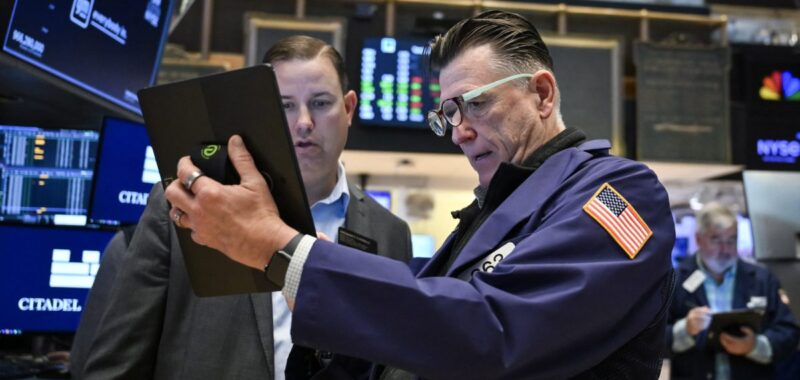
It was the week Wall Street got its swagger back. Stocks staged a gravity-defying rebound to wipe out all losses from April’s tariff shock, Corporate America unleashed billions in pent-up bond sales and speculative assets from crypto to unprofitable tech companies surged.
Yet beyond the relief rally — built on hopes that the White House will ink trade deals soon enough — the financial ecosystem is flashing warning signs for the likes of hedge funds and day traders plunging back into risk.
Signals in the bond market show the Federal Reserve in a policy bind, imperiling hopes that Jerome Powell & Co. can soften the tariff blow fast. The world’s reserve currency continues to lose its compass as it bucks moves in Treasury yields. And similar schisms are playing out in credit and equities as bulls defy elevated bankruptcies and falling earnings estimates.
While cross-asset contradictions are a regular feature of the trading landscape, the dislocations right now are worth heeding, according to Phil Pecsok, chief investment officer of Anacapa Advisors.
“We really don’t know if there’s going to be tariffs, relief from tariffs, lower taxes or retaliation. So it’s very hard to get the fundamental story straight,” he said. “Nobody knows anything. We are in no man’s land.”
As fast as traders bailed amid President Donald Trump’s tariff threats, they’ve stormed back, lifting US stocks in nine straight sessions, the most in two decades. Credit spreads have tightened amid a flurry of issuance while Bitcoin, which was trading as low as $77,053 three weeks ago, is again testing the six-figure mark.
Behind the runup: Speculation that the worst of Trump’s trade belligerence has been heard and signs that the US economy continues to hold up, with Friday data showing the unemployment rate held steady at 4.2%.
Yet in the underbelly of markets lingers skepticism that calls into question the $5 trillion equity recovery trade in less than two weeks. Measures of marketwide anxiety have eased but remain elevated. Even after falling for three weeks, Bank of America Corp.’s global financial stress indicator sits well above any level seen in the eight months prior to Trump’s “Liberation Day” warnings of April 2.
A key concern is that traders are charging back into risk on the conviction that Fed easing will be imminent, even though market-based inflation expectations have shown only tentative signs of cooling. While derivatives traders pared bets for interest-rate cuts following Friday’s jobs data, they still envision three reductions in 2025, up from one in February.
At the same time, one-year inflation swaps in early April rose to the highest level since 2022 amid worries about the impact of tariffs on import prices. Despite a pullback, they’re still more than 70 basis points higher than in January.
To Henry Allen, a macro strategist at Deutsche Bank AG, that’s a recipe for disappointment given Powell’s hawkish tone in his April speeches and the experience of 2022, when investors underestimated the Fed’s resolve in extinguishing price pressures.
“Markets risk repeating a consistent error of recent years, in pricing a Fed that is much too dovish compared to what actually happens,” he wrote in a recent note.
Allen also points to the uncomfortable fact that the dollar’s link with fixed income continues to fray. In theory, the US currency would be expected to appreciate against the euro when 10-year Treasury yields rise relative to comparable German bonds, or vice versa. That’s in part because higher-yielding assets attract money, bolstering the allure of the country’s currency. Yet that relationship has remained fractured since early April.
To Lawrence Creatura, a fund manager at PRSPCTV Capital LLC, the greenback’s weakness is a tell-tale sign that the US is losing its clout with global trading partners, bringing flashbacks of the Smoot-Hawley Tariff Act of 1930 that helped worsen the Great Depression.
“We are taking baby steps in that direction right now,” he said. “We’re going backwards in time and re-approaching that status where the dollar in the US is not a dependable, safe financial payment.”
The big risk-on surge is also occurring at a time when key fundamentals are weakening. Economists have been slashing their growth forecasts in anticipation of a hit from the trade war, while analysts are downgrading their estimates for corporate earnings for this year and next, data compiled by Bloomberg show. In the credit market, risk premiums for high yield debt have tightened since early April, despite bankruptcy filings rising to a five-year high.
Angst is also lingering in the options market. The Cboe Volatility Index, a measure of expected swings in the S&P 500, has seen its so-called spot prices stay above six-month futures contracts every session since late March. That’s the longest inversion since 2020’s pandemic crisis. It’s a sign traders continue to worry more about here and now than risk down the road.
All told, stubborn Wall Street frictions underscore the era of policy uncertainty under Trump 2.0, according to Maria Vassalou, head of the Pictet Research Institute.
“Since effectively the end of the Cold War, we had an environment of free trade, globalization and peace. And all these things are changing now,” she said. “We are moving into a different equilibrium, which is yet to be defined.”
This story was originally featured on Fortune.com

